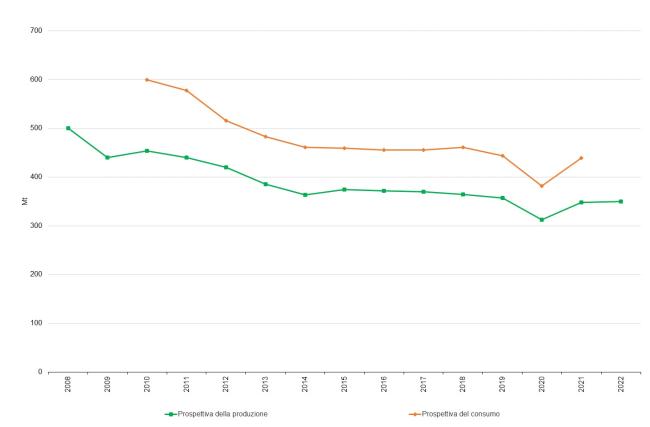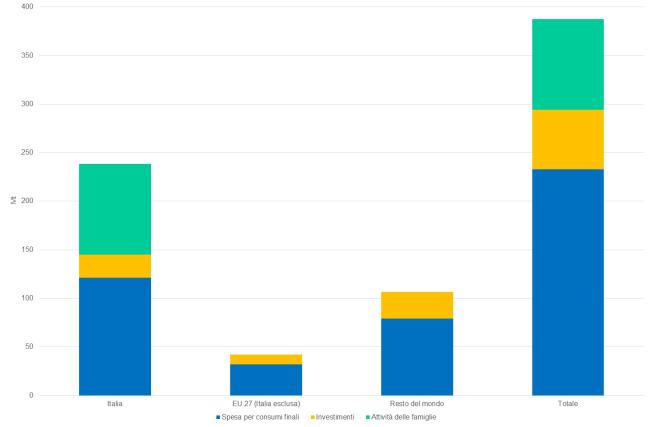Panel 1
Renato Marra Campanale
In 2021, in Italy, consumption and investments caused 439.5 Mt of CO2 (carbon footprint), equivalent to about 1.2% of global CO2 emissions, marking a 15% increase compared to the previous year. Of these, about 52 Mt come from the EU (excluding Italy) through imports, and 126 Mt from the rest of the world. Household activities, primarily from transport and heating, which are solely of Italian origin, account for about a quarter of the carbon footprint. The category of final demand that accounts for the largest share of the carbon footprint is final consumption expenditure (28%). About 12% of Italy's carbon footprint originates from the EU (excluding Italy), 7% from China, 4% from Russia, and 17% from the rest of the world.
The indicator measures the carbon dioxide (CO2) emissions arising from Italy's productive activities (production perspective) and the emissions attributed to internal final demand – final consumption expenditure and investments – of products consumed in Italy (consumption perspective). The latter perspective includes global emissions occurring along the global value chains of goods and services arriving in each country to be used by internal final demand (footprint).
The purpose is to monitor CO2 emissions ‘embedded’ in products destined for internal final demand (footprint), in order to track their environmental impact. Footprint estimates provide a complementary perspective to atmospheric emission inventories and accounts. Inventories and accounts record emissions from the production side, the source of emissions, while the footprint concept estimates emissions from the perspective of final goods and services.
Regulation (EU) No. 691/2011 on European environmental economic accounts (only for the production perspective).
Panel 2
Metadata del dataset Eurostat ‘env_ac_co2fp’: https://ec.europa.eu/eurostat/cache/metadata/en/env_ac_co2fp_esms.htm
-
-
Data quality assessment
EUROSTAT (Statistical Office of the European Communities), ISPRA (Italian National Institute for Environmental Protection and Research), ISTAT (Italian National Institute of Statistics)
Dataset Eurostat ‘env_ac_co2fp’: https://ec.europa.eu/eurostat/databrowser/view/env_ac_co2fp/default/table?lang=en
National
2008-2022 (prospettiva della produzione); 2010-2021 (prospettiva del consumo)
Indicator assessment
The source for estimating emissions from the production perspective is the atmospheric emissions accounts.
Emissions from the consumption perspective are not directly observable. They derive from the environmental extension of the FIGARO (Full International and Global Accounts for Research in Input-Output analysis) multiregional input-output economic model produced by Eurostat.
Compared to the European average, this indicator shows a good status for Italy in 2021 from the production perspective (5.9 tons per capita, compared to 6.7 in the EU), while for the consumption perspective, the Italian per capita data does not differ much from the European average (7.4 tons per capita, compared to 7.8 in the EU).
Despite the substantial stability of the indicator (both from the production and consumption perspectives) from 2014-2019, and the subsequent drastic reduction due to the pandemic crisis in 2020 and 2021, Italy's carbon footprint has started to increase again due to economic recovery.
Data
Table 1: Global CO₂ emissions – Italy in relation to the EU and the rest of the world (2021)
ISPRA elaboration based on Eurostat data
Table 2: CO₂ emissions due to Italian consumption by country of origin (2021)
ISPRA analysis based on Eurostat data
Table 3: CO₂ emissions produced in Italy by destination country of use (2021)
ISPRA elaboration based on Eurostat data
Table 4: CO₂ emissions by perspective in Italy
Elaborazione ISPRA su dati Eurostat


In 2021, CO2 emissions from Italian consumption (carbon footprint) were 25% higher than those generated by economic activities (production perspective). This gap is in line with the average for the 2010-2021 period. CO2 generated according to both perspectives decreased by 23% (production perspective) and 27% (consumption perspective) from 2010 to 2021 but increased by 11% and 15%, respectively, from 2020 to 2021 (Figure 1, Table 4). In 2021, Italy produced 348 million tons (Mt) of CO2, which represents just under 1% of global emissions (around 38 billion tons). Of these, 261 Mt were for internal Italian final demand (consumption and investment), and, through Italy's exports of goods and services, 35 Mt were for European final demand (excluding Italy), and 52 Mt were for the final demand of the rest of the world (Table 1). Similarly, the European Union (EU, excluding Italy) produced 2.6 billion tons of CO2, equivalent to 7% of global CO2, of which over 2 billion tons were destined for EU consumption and investment (excluding Italy), 0.05 billion tons for Italian final demand, and 0.6 billion tons for the final demand of the rest of the world.
Changing perspective, Italian consumption and investments caused 439.5 Mt of CO2, equivalent to 1.2% of global CO2 emissions. Of these, 52 Mt derive from the EU (excluding Italy) through imports, and 126 Mt from the rest of the world. The final demand of the EU (excluding Italy) accounted for over 3 billion tons of CO2 (about 8% of global CO2). 0.035 billion tons and almost 1 billion tons were produced, respectively, in Italy and the rest of the world (Table 1). Table 2 presents Italy's CO2 by the origin of these emissions, i.e., the countries or geographic areas where the CO2 was emitted to produce goods and services intended for the Italian economy. In 2021, CO2 from Italy's final demand (439.5 Mt) originated almost 60% from the Italian economy itself. Just under 12% came from the EU (excluding Italy). The other countries where CO2 emissions consumed in Italy were produced include: China (7%), Russia (4%), India (2%), the United States, and Turkey (1%). The remaining 13% originated from other countries worldwide.
As shown in Figure 2, excluding household activities (transport, heating, etc.), whose emissions originate only in Italy, the category of Italian final demand to which the largest share of the carbon footprint is attributed is final consumption expenditure. Table 3 shows the destination of CO2 emissions produced in Italy, i.e., the countries where the final uses of products take place, causing CO2 emissions by the Italian economy. In 2021, these emissions (347.8 Mt) were destined for the Italian economy’s production needs, accounting for about three-quarters. Almost 10% was destined for the consumption of the EU (excluding Italy), 3% for the United States, and 2% for China. All other countries accounted for about 10%.